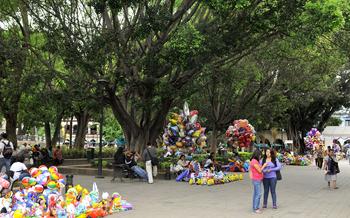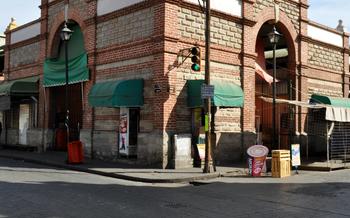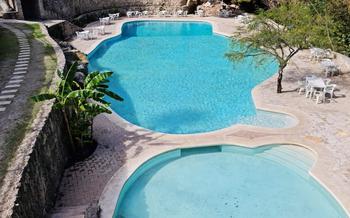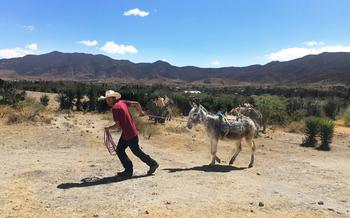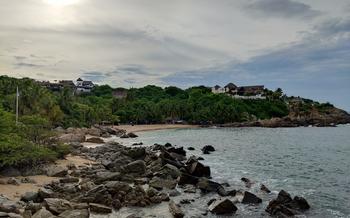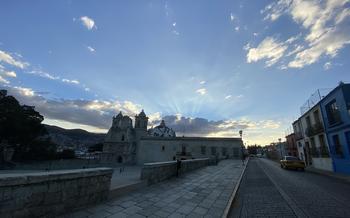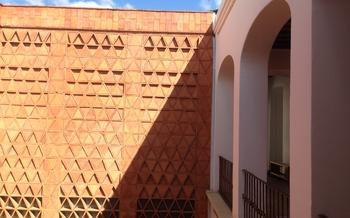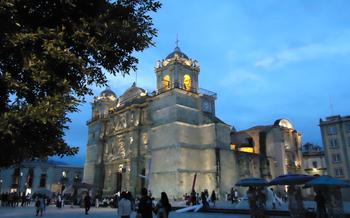
Basílica de Nuestra Señora de la Soledad
- History and Cultural Significance
- Location and Accessibility:
- Religious Ceremonies and Celebrations
- Art and Architecture
- Pilgrimage and Spirituality
- Local Traditions and Customs
- Photography and Videography
- Museum and Exhibitions:
- Shopping and Souvenirs:
- Food and Drink
- Accessibility and Facilities
- Safety and Security:
- Dress Code and Etiquette
- Language and Communication
- Insider Tip: For a truly unforgettable experience, plan your visit to the Basílica de Nuestra Señora de la Soledad during the annual "Fiesta de la Soledad" held in December. This week-long celebration features colorful processions, traditional music and dance performances, and a lively fair filled with food, crafts, and religious souvenirs. Immerse yourself in the vibrant Oaxacan culture as you witness the devotion and joy of the pilgrims who flock to the basilica during this special time.
History and Cultural Significance
The Basílica de Nuestra Señora de la Soledad, a majestic architectural masterpiece located in the heart of Oaxaca, stands as a testament to the city's rich history and cultural heritage. Built in the 17th century, this sacred edifice holds a profound significance for the people of Oaxaca, serving as a pilgrimage site and a focal point of religious devotion. The basilica's unique architectural style, blending elements of Baroque, Gothic, and Neoclassical design, reflects the city's diverse artistic influences. Its interior is adorned with intricate artwork, stunning murals, and ornate altars, creating a visually captivating space that inspires awe and reverence. The basilica is not just a religious landmark but also a symbol of Oaxaca's cultural identity, embodying the deep-rooted faith and traditions of its people.
Location and Accessibility:
The Basílica de Nuestra Señora de la Soledad is conveniently situated in the heart of Oaxaca City, making it easily accessible to visitors. It is located on the corner of Avenida Independencia and Calle 20 de Noviembre, just a short walk from the city's main square, the Zócalo.
To get to the basilica, you can take public transportation or drive your own vehicle. Several bus lines stop within walking distance of the basilica, and there are ample parking options nearby for those who prefer to drive.
The basilica is open to the public daily from 7 am to 7 pm, and there is no entrance fee. Visitors are welcome to explore the basilica's interior, attend religious services, or simply admire its stunning architecture from afar.
Insider Tip:
For the best photography opportunities, visit the basilica early in the morning or late in the afternoon when the light is softer and more flattering. The basilica's intricate facade and colorful domes are particularly striking at these times of day.
Religious Ceremonies and Celebrations
The Basílica de Nuestra Señora de la Soledad is a hub of religious activity throughout the year, with various ceremonies and celebrations that draw pilgrims and devotees from near and far. The most significant event is the annual "Fiesta de la Soledad," held on December 18th. This grand festival honors the patron saint of Oaxaca, the Virgin of Soledad, and features elaborate processions, traditional dances, and fireworks displays. Other important religious events include Holy Week processions, the feast day of Our Lady of Guadalupe on December 12th, and the feast day of Saint Francis of Assisi on October 4th. During these celebrations, the basilica is adorned with colorful decorations, flowers, and intricate carpets made from colored sawdust. Visitors are welcome to attend these religious ceremonies, but it is important to be respectful and observe local customs, such as dressing modestly and maintaining silence during prayers. The best time to visit the basilica to witness these vibrant celebrations is during the festival season, from December to January.
Art and Architecture
The Basílica de Nuestra Señora de la Soledad stands as a testament to the unique blend of architectural styles that characterizes Oaxaca. Its facade showcases a combination of Baroque and Neoclassical elements, with intricate carvings adorning its entrance and bell towers. The interior of the basilica is equally impressive, featuring a magnificent altar that dominates the main nave. The altar features a stunning image of the Virgin of Solitude, surrounded by intricate and colorful carvings. The walls are adorned with murals depicting scenes from the life of Mary and other biblical figures. The basilica is also home to a collection of religious relics and artifacts, including a piece of the true cross, which is displayed in a special reliquary.
Pilgrimage and Spirituality
The Basílica de Nuestra Señora de la Soledad holds immense significance as a pilgrimage site, attracting countless devotees from across Mexico and beyond. Pilgrims embark on arduous journeys to pay homage to the revered image of Our Lady of Solitude, seeking blessings, divine intervention, and spiritual solace.
Upon arriving at the basilica, pilgrims often engage in various rituals and traditions to express their devotion. These may include lighting candles, offering flowers and prayers, crawling on their knees towards the altar, or circumambulating the basilica. The atmosphere is palpable with a sense of reverence, faith, and collective spirituality.
Numerous stories and legends are associated with the basilica and its miraculous powers. Believers recount tales of healings, answered prayers, and divine interventions attributed to the intercession of Our Lady of Solitude. The basilica serves as a beacon of hope and comfort, where pilgrims find solace, strength, and renewal amidst their struggles and uncertainties.
Local Traditions and Customs
The Basílica de Nuestra Señora de la Soledad is deeply embedded in the local traditions and customs of Oaxaca. For the Oaxacan people, the basilica serves as a spiritual and cultural hub, where religious practices, community gatherings, and festive celebrations intertwine.
During the annual "Fiesta de la Soledad," held in December, the basilica becomes the epicenter of a week-long celebration that draws thousands of pilgrims and visitors from across the region. The streets surrounding the basilica are adorned with colorful decorations, food stalls, and lively music, creating a vibrant atmosphere of joy and devotion.
One unique tradition associated with the basilica is the "peregrinaciones," or pilgrimages, undertaken by faithful devotees from distant towns and villages. These pilgrimages often involve walking long distances, carrying heavy religious objects, and reciting prayers along the way. Upon reaching the basilica, pilgrims pay homage to the Virgin of Solitude, seeking her blessings and intercessions.
The basilica also plays a significant role in the everyday lives of the Oaxacan people. Many locals visit the basilica regularly to pray, light candles, and offer their devotions to the Virgin. The basilica's courtyard often serves as a gathering place for community events, such as religious processions, baptisms, and weddings, further solidifying its importance in the local social fabric.
Photography and Videography
The Basílica de Nuestra Señora de la Soledad welcomes photography and videography for personal and non-commercial purposes. Visitors are encouraged to capture the basilica's beauty and share their experiences with others. However, there are a few restrictions and guidelines to keep in mind.
Photography and Videography Guidelines:
Respect the Sacred Space: Remember that the basilica is a sacred place of worship and prayer. Be respectful of ongoing religious ceremonies and services, and avoid disrupting or disturbing worshippers.
Use Flash with Caution: The use of flash photography is generally discouraged inside the basilica, as it can be distracting and disruptive. If you do need to use flash, be sure to ask permission from the basilica staff or a member of the clergy.
Limit Tripods: Tripods are not permitted inside the basilica due to space constraints and safety concerns. If you wish to use a tripod, please check with the basilica staff for designated areas where tripods are allowed.
Capture the Details: Take your time to explore the basilica's interior and capture the intricate details of its architecture, artwork, and religious relics. Look for unique angles and perspectives to make your photos stand out.
Share Your Experience: Share your photos and videos of the Basílica de Nuestra Señora de la Soledad on social media, using the hashtag #BasilicaDeLaSoledad. This helps promote the basilica and allows others to experience its beauty and significance.
Museum and Exhibitions:
Within the Basílica de Nuestra Señora de la Soledad, visitors can delve deeper into the rich history and cultural significance of the basilica through its on-site museum. This museum houses a collection of artifacts, artwork, and historical documents that provide insights into the basilica's construction, religious traditions, and the devotion to Our Lady of Solitude.
The museum showcases a variety of exhibits, including religious vestments, paintings, sculptures, and relics associated with the basilica. Visitors can learn about the symbolism and iconography found throughout the basilica, as well as the stories and legends that have shaped its spiritual legacy. The museum also offers educational programs and guided tours that provide a deeper understanding of the basilica's significance and its role in Oaxacan culture.
Shopping and Souvenirs:
The Basílica de Nuestra Señora de la Soledad is a popular destination for pilgrims and tourists alike, and as such, there are several shops and stalls in the vicinity where visitors can purchase souvenirs and religious items. These shops offer a wide range of items, including candles, rosaries, statues, and other devotional objects. Visitors can also find traditional Oaxacan crafts and souvenirs, such as woven textiles, pottery, and jewelry. Many of these items are handmade by local artisans, and purchasing them is a great way to support the local economy and take home a unique piece of Oaxacan culture.
Food and Drink
After exploring the sacred halls of the Basílica de Nuestra Señora de la Soledad, tantalize your taste buds with the culinary delights that await you nearby. Immerse yourself in the flavors of Oaxaca, renowned for its rich and diverse cuisine.
Stroll along the picturesque streets surrounding the basilica, where you'll find an array of inviting restaurants and cafes. Savor the aromatic delights of traditional Oaxacan dishes, such as the iconic mole negro, a complex and flavorful sauce served with chicken or pork. Indulge in the crispy goodness of tlayudas, large tortillas topped with beans, cheese, and various meats.
For a refreshing respite, sip on a glass of tejate, a traditional Oaxacan beverage made with corn, cocoa, and flor de cacao. Its unique flavor profile will quench your thirst and leave you craving more.
Don't miss the opportunity to visit the bustling Mercado de Benito Juárez, located just a short walk from the basilica. This vibrant market is a foodie's paradise, offering an array of fresh produce, spices, and local delicacies. Sample the mouthwatering street food, from succulent barbacoa tacos to crispy empanadas, and soak in the lively atmosphere that encapsulates the essence of Oaxacan culinary culture.
Accessibility and Facilities
The Basílica de Nuestra Señora de la Soledad offers various accessibility features to ensure inclusivity and comfort for all visitors. Wheelchair users and individuals with disabilities will find ramps and elevators throughout the basilica, making it easy to navigate the premises. Restrooms with accessible stalls are available within the basilica for added convenience. Drinking water fountains are also strategically placed to keep visitors hydrated during their visit. For those who require assistance or have specific needs, the basilica's staff is friendly and helpful, ready to provide guidance and support.
Safety and Security:
The Basílica de Nuestra Señora de la Soledad is generally considered a safe place to visit, especially during daytime hours. However, as with any tourist destination, it is essential to be aware of your surroundings and take necessary precautions to protect your belongings and personal safety. Keep an eye on your valuables, such as wallets, cameras, and phones, and avoid carrying large amounts of cash. Be wary of pickpockets, especially in crowded areas. It is advisable to dress modestly and respectfully when visiting the basilica, as revealing clothing may attract unwanted attention. If you have any concerns or encounter any issues, do not hesitate to approach the basilica's security personnel or local authorities for assistance.
Dress Code and Etiquette
When visiting the Basílica de Nuestra Señora de la Soledad, it is essential to be respectful of the religious nature of the site. Visitors should dress modestly and avoid wearing shorts, tank tops, or revealing clothing. Shoulders and knees should be covered, and clothing should not be too tight or transparent. Men are required to remove their hats upon entering the basilica. It is also important to be mindful of your behavior and maintain a respectful silence while inside the basilica. Photography and videography are generally permitted, but visitors should be discreet and avoid using flash or disturbing other worshippers.
Language and Communication
The official language of Oaxaca is Spanish, and while English is spoken in some tourist areas, it is not widely understood at the Basílica de Nuestra Señora de la Soledad. To communicate effectively with locals and ask for directions or information, it is helpful to learn a few basic Spanish phrases. Visitors can also find multilingual guides or resources at the basilica to assist them with translation and interpretation.
To enhance the travel experience and show respect for the local culture, it is recommended to make an effort to communicate in Spanish. Locals are generally friendly and welcoming to tourists, and they appreciate visitors who try to speak their language.

